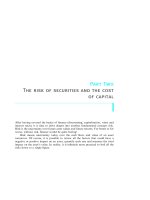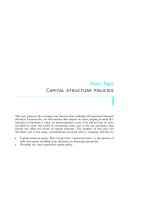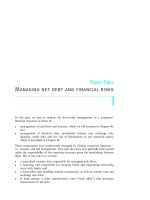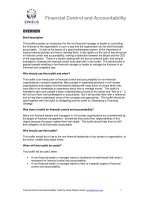Chapter 2: Internal Control Deficiencies _part6 potx
Bạn đang xem bản rút gọn của tài liệu. Xem và tải ngay bản đầy đủ của tài liệu tại đây (405.18 KB, 9 trang )
63
Comments on
Agency Response
Response of the Affected Agency
We transmitted a draft of this report to the Department of Human
Resources Development on November 14, 2007. A copy of the
transmittal letter to the department is included as Attachment 1. The
response of the department is included as Attachment 2.
The department expressed its appreciation of the value of audits but did
disagree with many of our findings and conclusions. The department
provided detailed explanations supporting its disagreement with our
findings. However, the department’s responses either do not specifically
address, or demonstrate a lack of understanding of, the actual findings.
The department disagrees with our audit finding concerning the level and
source of financial information it submits to the Legislature. The
department supports its claim by noting it generates numerous reports
from the Human Resource Management System, which support the
reports submitted annually to the Legislature and posted to the
department’s website. We are aware of, and reviewed, these reports
during our audit. However, this system generates statistical information
pertaining only to workers’ compensation balances. Our audit notes the
lack of department-wide financial reports showing the financial position
and results of operations for the department as a whole. These reports
should be prepared in accordance with applicable accounting standards to
ensure comparability with other agencies. This type of information is not
available in the mentioned system and is not currently being submitted to
the Legislature.
The department disagrees with our conclusion that overstatements of
fund balances occurred because accounting personnel and accurate
financial reporting are not department priorities. Our conclusion is based
on the accumulation of several identified accounting misstatements and
errors resulting from a lack of qualified financial accounting personnel.
We do acknowledge the department’s proficiency with day-to-day
accounting operations; however, the department has not dedicated
appropriate resources to developing formal internal and external financial
reporting systems that can mitigate such misstatements and errors.
The department disagrees with our conclusive statement that it does not
take functional ownership over the Workers’ Compensation Program. In
disagreement with our assessment that workers’ compensation liabilities
are not systematically calculated, tracked, and reported, the department
further notes that it does provide reserve data to all state departments for
inclusion in their financial statements as well as in the statewide
This is trial version
www.adultpdf.com
64
Comprehensive Annual Financial Report (CAFR). However, the
June 30, 2006 State of Hawaii, Report on Internal Controls over
Financial Reporting and on Compliance and Other Matters, issued in
conjunction with the CAFR audit, specifically stated that the State
acknowledged that claims reserves reports are “inaccurate and unreliable
for purposes of determining the State’s estimated workers’ compensation
liability” and as a result, the State “continues to estimate its workers’
compensation claims liability based on payroll information and insurance
filings, as done in previous years.” Our testing of claims’ reserves
validated this criticism, as we found significant and systematic errors in
the calculation of individual workers’ compensation claim liabilities.
We concluded the department has not taken ownership over the Workers’
Compensation Program as it does not recognize the $29 million in related
liabilities, calculate accurate reserves, or have formal claims processing
procedures. A major point of our finding is that the department is unable
to properly report the workers’ compensation reserve liability in
accordance with generally accepted accounting principles (GAAP) and
that the department’s personnel informed us on several occasions that
this was not a department priority.
The department also disputes our statement that the department does not
understand or calculate the Incurred But Not Reported (IBNR) portion of
the workers’ compensation claims liability, citing an IBNR report
prepared by the department and submitted for inclusion in the statewide
CAFR. During our audit we reviewed the report in question, noting that
it simply lists claims filed within three months subsequent to the fiscal
year end (June 30, 2006). However, IBNR calculations are much more
complex than this and must take into account the fact that workers’
compensation claims can be filed years after the date of injury. The
IBNR calculation prepared by the department does not comply with
financial accounting and reporting requirements specified by GAAP.
The department responds that our audit report incorrectly suggests that
deficient departmental processes are responsible for alleged time lags
between the posting and disbursement of workers’ compensation
payments. The department explains that time lags are inherent, as
payments are posted daily by the department but actual payments are
subsequently made by the Department of Accounting and General
Services. We are aware of the nature of these time lags; however, our
finding focuses on instances in which the reserve liability was misstated
due to the recordation of authorized payments rather than actual
payments, which occur at a later date.
This is trial version
www.adultpdf.com
This is trial version
www.adultpdf.com
This is trial version
www.adultpdf.com
This is trial version
www.adultpdf.com
This is trial version
www.adultpdf.com
This is trial version
www.adultpdf.com
This is trial version
www.adultpdf.com
This is trial version
www.adultpdf.com









